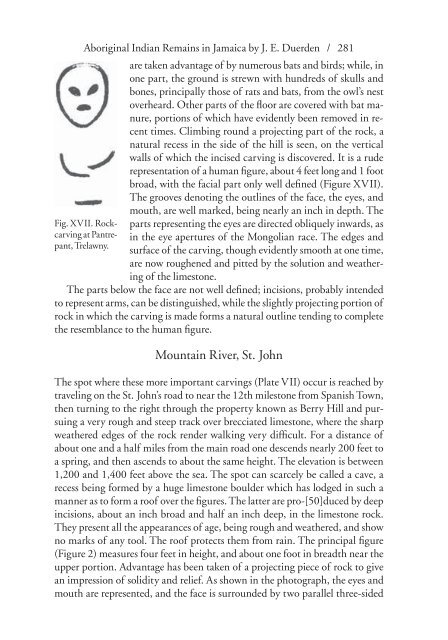Pre-Colombian Jamaica: Caribbean Archeology and Ethnohistory
by Phillip Allsworth-Jones
by Phillip Allsworth-Jones
Create successful ePaper yourself
Turn your PDF publications into a flip-book with our unique Google optimized e-Paper software.
Aboriginal Indian Remains in <strong>Jamaica</strong> by J. E. Duerden / 281<br />
are taken advantage of by numerous bats <strong>and</strong> birds; while, in<br />
one part, the ground is strewn with hundreds of skulls <strong>and</strong><br />
bones, principally those of rats <strong>and</strong> bats, from the owl’s nest<br />
overheard. Other parts of the floor are covered with bat manure,<br />
portions of which have evidently been removed in recent<br />
times. Climbing round a projecting part of the rock, a<br />
natural recess in the side of the hill is seen, on the vertical<br />
walls of which the incised carving is discovered. It is a rude<br />
representation of a human figure, about 4 feet long <strong>and</strong> 1 foot<br />
broad, with the facial part only well defi ned (Figure XVII).<br />
The grooves denoting the outlines of the face, the eyes, <strong>and</strong><br />
mouth, are well marked, being nearly an inch in depth. The<br />
Fig. XVII. Rock- parts representing the eyes are directed obliquely inwards, as<br />
carving at Pantrepant,<br />
Trelawny.<br />
in the eye apertures of the Mongolian race. The edges <strong>and</strong><br />
surface of the carving, though evidently smooth at one time,<br />
are now roughened <strong>and</strong> pitted by the solution <strong>and</strong> weathering<br />
of the limestone.<br />
The parts below the face are not well defined; incisions, probably intended<br />
to represent arms, can be distinguished, while the slightly projecting portion of<br />
rock in which the carving is made forms a natural outline tending to complete<br />
the resemblance to the human figure.<br />
Mountain River, St. John<br />
The spot where these more important carvings (Plate VII) occur is reached by<br />
traveling on the St. John’s road to near the 12th milestone from Spanish Town,<br />
then turning to the right through the property known as Berry Hill <strong>and</strong> pursuing<br />
a very rough <strong>and</strong> steep track over brecciated limestone, where the sharp<br />
weathered edges of the rock render walking very difficult. For a distance of<br />
about one <strong>and</strong> a half miles from the main road one descends nearly 200 feet to<br />
a spring, <strong>and</strong> then ascends to about the same height. The elevation is between<br />
1,200 <strong>and</strong> 1,400 feet above the sea. The spot can scarcely be called a cave, a<br />
recess being formed by a huge limestone boulder which has lodged in such a<br />
manner as to form a roof over the figures. The latter are pro-[50]duced by deep<br />
incisions, about an inch broad <strong>and</strong> half an inch deep, in the limestone rock.<br />
They present all the appearances of age, being rough <strong>and</strong> weathered, <strong>and</strong> show<br />
no marks of any tool. The roof protects them from rain. The principal figure<br />
(Figure 2) measures four feet in height, <strong>and</strong> about one foot in breadth near the<br />
upper portion. Advantage has been taken of a projecting piece of rock to give<br />
an impression of solidity <strong>and</strong> relief. As shown in the photograph, the eyes <strong>and</strong><br />
mouth are represented, <strong>and</strong> the face is surrounded by two parallel three- sided


















